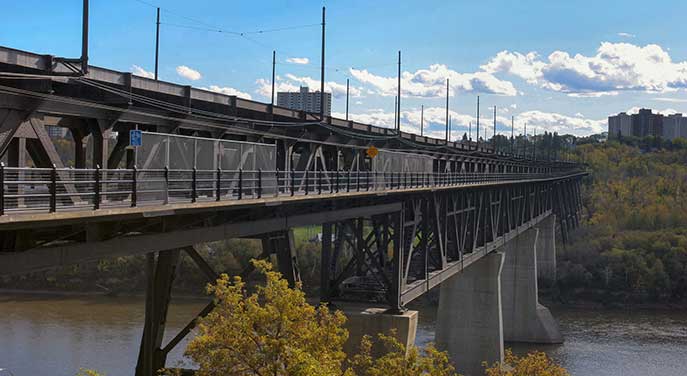 EDMONTON: There has been much chit-chat among the chatterers of our fair city regarding the future of a two-lane, 109-year-old bridge that is the main route from Edmonton’s fast-growing south side to the downtown.
EDMONTON: There has been much chit-chat among the chatterers of our fair city regarding the future of a two-lane, 109-year-old bridge that is the main route from Edmonton’s fast-growing south side to the downtown.
To this day, the iconic, historic High Level Bridge is visually impressive.
It’s very long, and very high, crossing the North Saskatchewan River valley from the city’s south-side bank-top to the downtown alongside the Provincial Legislature.
The original railway look – all sturdy black metal – has been maintained. It’s easy to imagine the Canadian Pacific’s big ol’ steam engines huffing and puffing as they pulled their loads across the bridge.
After all, that’s what it was built for.
There’s only one, big glaring problem.
The one-way southbound bridge is only TWO lanes wide, with the weirdest entry and exit points you ever saw.
Which is understandable. Once again, hey, it was built for trains, not for cars.
Driving the other way, into Edmonton’s downtown from the south-side, is now quite excellent thanks to a new, one-way north-bound FOUR-lane Walterdale Bridge, about a kilometre downstream from the High Level.
The Walterdale Bridge is excellent … once you have negotiated the equally weird hairpin turns needed to drive down into the river valley to access the bridge.
Heading home, however, on the High Level Bridge in the late afternoon is a daily nightmare.
The two very narrow lanes can’t accommodate today’s traffic flow at the best of times, let alone when one lane is blocked or when a truck jams the entrance, as happens about once a month.
The High Level Bridge is a few years from another cycle of rehab/repair/renovation. Thus, the city engineers, as they do about every 30 years with bridges, are presenting city council with options.
Here’s the giant rub: Other than building an additional new bridge (which is probably the best solution), there’s not the least thought given to INCREASING TRAFFIC CAPACITY!
This seems quite extraordinary, a classic case of ignoring the obvious for the sake of political correctness.
The most pressing need is to increase vehicle capacity on the bridge and improve traffic flows.
But nobody dares bring this up!
Because nobody is allowed to acknowledge the problem!!!
For some 50 years, it has been compulsory for urban planners and progressive politicians to be anti-car.
Urban planners – bike-riders all – seem to hate cars. Cars! The ultimate in North American consumer excess – all that mass and energy to transport just one person! Cars! How dare they drive when they should be on mass transit – on which billions have been spent but nobody rides.
Cars, taking up precious downtown parking! Cars! Oil & gas guzzlers! Cars! Stinking, fume-spewing, toxic polluters! (Which is an utter falsehood, not with current technology and with EVs – electronic vehicles – around the corner.)
Those attitudes have become embedded in Canadian urban planning. Officially, cities give mass transit much higher priority than roadways. You won’t find a city planner anywhere who would be so bold as to publicly argue the case for cars. Tut, tut, old boy! Just not done!
But undeniable facts refuse to go away.
Until mass transit becomes as convenient and versatile as private vehicles, the vast majority of Canadians will continue to buy cars, only using mass transit if they can’t afford a car.
We live in a terribly cold urban city. Who wants to wait for a bus? Cars keep us warm!
Most young Canadian families dream of living in a big suburban house with at least a little grass, two cats in the yard and a barbecue to boot … where at least one car is a must.
Developers create car-oriented neighbourhoods way out in the ‘burbs … because THAT IS WHAT MOST PEOPLE WANT!!!
So why don’t we acknowledge these glaring truths? Why don’t we encourage the purchase of smaller cars, encourage fewer cars per household, encourage work-at-home careers – as is happening!
Back to the High Level Bridge.
A win-win solution is in front of our noses.
A brand-new bridge should be built – let’s say a replica of the attractive Walterdale Bridge to save on design and engineering costs – to handle south-bound traffic.
Keep the High Level Bridge – without any traffic!
Transform it into an unusual urban walkway with those beloved bicycle paths, that cute street car, real grass and Dickie Dee ice cream trucks, even though it will be dead when it’s too cold (like seven months of the year). Hey, ice down the bike paths so 100 people a day can skate to work!
Spend a minimum on the bridge’s bones – it won’t have to carry vehicle loads.
Really, there is no other answer – not if ease of transport in the private car is also counted as something that’s good for a city, along with bike lanes and ice cream trucks.
Graham Hicks is a freelance journalist and occasional commentator. From 1992 to 2010, he wrote the popular Hicks on Six column for the Edmonton Sun.
Graham is a Troy Media Thought Leader. For interview requests, click here.
The opinions expressed by our columnists and contributors are theirs alone and do not inherently or expressly reflect the views of our publication.
© Troy Media
Troy Media is an editorial content provider to media outlets and its own hosted community news outlets across Canada.


There are core beliefs that impact everything we do. Until there is a paradigm shift in what we believe, there will be no solutions to many of the problems that plague our civilization. Fundamentally, this is about what we value and how we perceive ourselves, something that is very hard to change because we all believe what we believe, even in the face of evidence that it is not true.
We as humans believe “narratives” and really are not factually or science-driven. For instance, we have a narrative about a green economy that our elites like to talk about, where we all drive electric cars, and somehow the world becomes unpolluted. There is nothing factual about the narrative, and in fact, the green economy will likely be more, not less polluting.
Are there solutions to these problems? I believe there are, but I also believe these problems will be solved from the bottom up, not from the top down. Why? Because we actually don’t know what will work! To discover what will work, we need lots of experiments where different communities try different solutions to their different problems. We need to focus on values, and community.
Let me give an example. Food production. We have chosen to focus on industrial food production systems. By doing this, we have created a convenient lifestyle. Still, we have also created a “Landfill Economy” If we decentralized our food production, we would all spend a lot more time in the garden (maybe even a High Tech Garden) and taking care of chickens. Still, our food supply would be far more resilient, we would have a lot less food waste, and we would drive less as we would stay closer to home. We would know our neighbours and have a much stronger local economy as neighbourhoods would produce much needed at home.
To be frank, we would live in a much more interesting and vibrant world.
What I just proposed is possible and much more ecologically and environmentally sustainable. The primary reason why it is unlikely to happen is that for it to happen, we would all need to think differently.